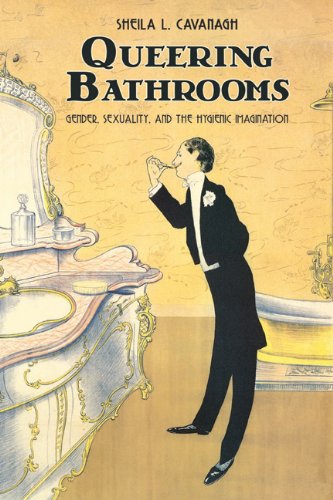Gender, Excretion and Shockingly Stupid Academia
May 16, 2016

JOSH G. writes:
I wanted to pass along a link to a book that simply has to be seen to be believed, Queering Bathrooms: Gender, Sexuality, and the Hygienic Imagination by Sheila L. Cavanagh (University of Toronto Press, 2010). As Wikipedia tells it:
Cavanagh’s most recent book, the groundbreaking Queering Bathrooms: Gender, Sexuality, and the Hygienic Imagination, was a 2011 Finalist for the GLBT Next Generation Indie Book Awards. In 2012, Queering Bathrooms received the CWSA/ACEF Outstanding Scholarship Prize Honourable Mention. Queering Bathrooms “brings to light one of the last remaining forms of discrimination and segregation that goes unquestioned”.[5] Fuse Magazine reviewer Syrus Ware writes that Queering Bathrooms “provides a strong argument for reconsidering the public toilet, making it a must-read for city and urban planners, policy makers, architects and designers. Queering Bathrooms offers important recommendations about the future of bathroom design, suggests areas for future research, and imagines a future in which public toilets are at once luxurious, accessible and welcoming to all human beings”.[6]
I spent an hour or so reading this last night; it’s the zeitgeist in 200 pages. The agenda is as clearly stated as anything written by a “studies” professor can possibly be: make the world safe for sodomy. If I had more time, I would excerpt some of the more absurd parts.
Laura writes:
I took a look. It does shed some light on bathroom warriors and their warped defenders in academia.
Basically, according to Cavanaugh, who received gobs of support from the academic establishment, traditional hygiene is pathological. It’s a form of “homophobia.” Bathrooms must be totally redesigned to be less hateful.
Her work is heavily influenced by the French literary theorist Michel Foucault, who is largely responsible, as E. Michael Jones has written, for turning academics into homosexual crusaders. From the introduction of Queering Bathrooms:
The management of the body and its modes of evacuation in the modern lavatory are part and parcel of the regulation of gender and sexuality in the modern era. The elimination function is an area of bio-political regulation that is often designated ‘out of scholarly bounds’ (not to mention crude and subject to interdiction in polite discourse), yet, curiously, central to an overemphasis upon an absolute and unchanging sexual difference. Robyn Longhurst (2001), in her study of body, fluids and excremental space, notes that toilets are “one of geography’s abject and illegitimate sites” that have been deemed (perhaps unconsciously) inappropriate and improper by the hegemons in the discipline. Yet ideas about what is a ‘proper,’ ‘worthy,’ and ‘respectable’ topic of inquiry operate to censor, repress, and prohibit but also, as Foucault (1978) tells us, to map the terrain of the thinkable, the analysable. Queering Bathrooms argues that obsessive investments in ‘urinary segregation’ (Lacan 2006) by gender is about a perceived threat to heteronormativity. It becomes considerably harder to delineate who is gay and who is lesbian when it is not clear who is a male or a man and who is a female or a woman.
This book endeavours to theorize how and why the public washroom is a site for gender-based hostility, anxiety, fear, desire, and unease in the present day as the washroom is also a site for homoerotic desire. Queering Bathrooms is concerned with the nuances and vicissitudes of trans and homophobic hate and the harm incurred by gender-exclusionary spatial designs.
I guess women will have to get used to urinals and being raped in restrooms. Anything else would be hateful segregation. We are become increasingly unworthy of modern plumbing.
Though she does not mention this book specifically, Heather Mac Donald has a related article at National Review, where she writes:
One take-away from the transgender-bathroom wars is that the public ignores arcane academic theory at its peril. For two decades, a growing constellation of gender-studies, queer-studies, and women’s-studies departments have been beavering away at propositions that would strike many people outside academia as surprising — such as that biological sex and “gender” are mere ideological constructs imposed by a Eurocentric, heteronormative power structure. Even though skeptical journalists have regularly dived into the murky swamp of academic theory and returned bearing nuggets of impenetrable jargon and even stranger ideas, the public and most politicians have shrugged off such academic abominations, if they have taken note at all. (Senator Marco Rubio’s deplorable jab at “philosophy majors” during his presidential run demonstrated how clueless your typical politician is about the real problems in academia.)
She also says, and I concur:
The ultimate agenda here, however, is to destroy any last shred of female modesty that might stand in the way of the total normalization of casual promiscuity, in obedience to the sexual-liberation movement of the 1960s. Many girls are embarrassed to be seen naked by other girls. Now, however, they are being told to swallow their inhibitions if a boy is in their bathroom or locker room. This can be achieved only by adopting a stance of utter indifference to the powerful, primal taboos around nakedness and sex — in other words, to adopt the sad sexual crudeness of the stars of Sex and the City or of Lena Dunham. And according to the Obama administration, any parent or school official who disagrees is standing in the way of moral progress. One shrinks to contemplate what the academy is cooking up next.
And the goal is to destroy male and female altogether.
